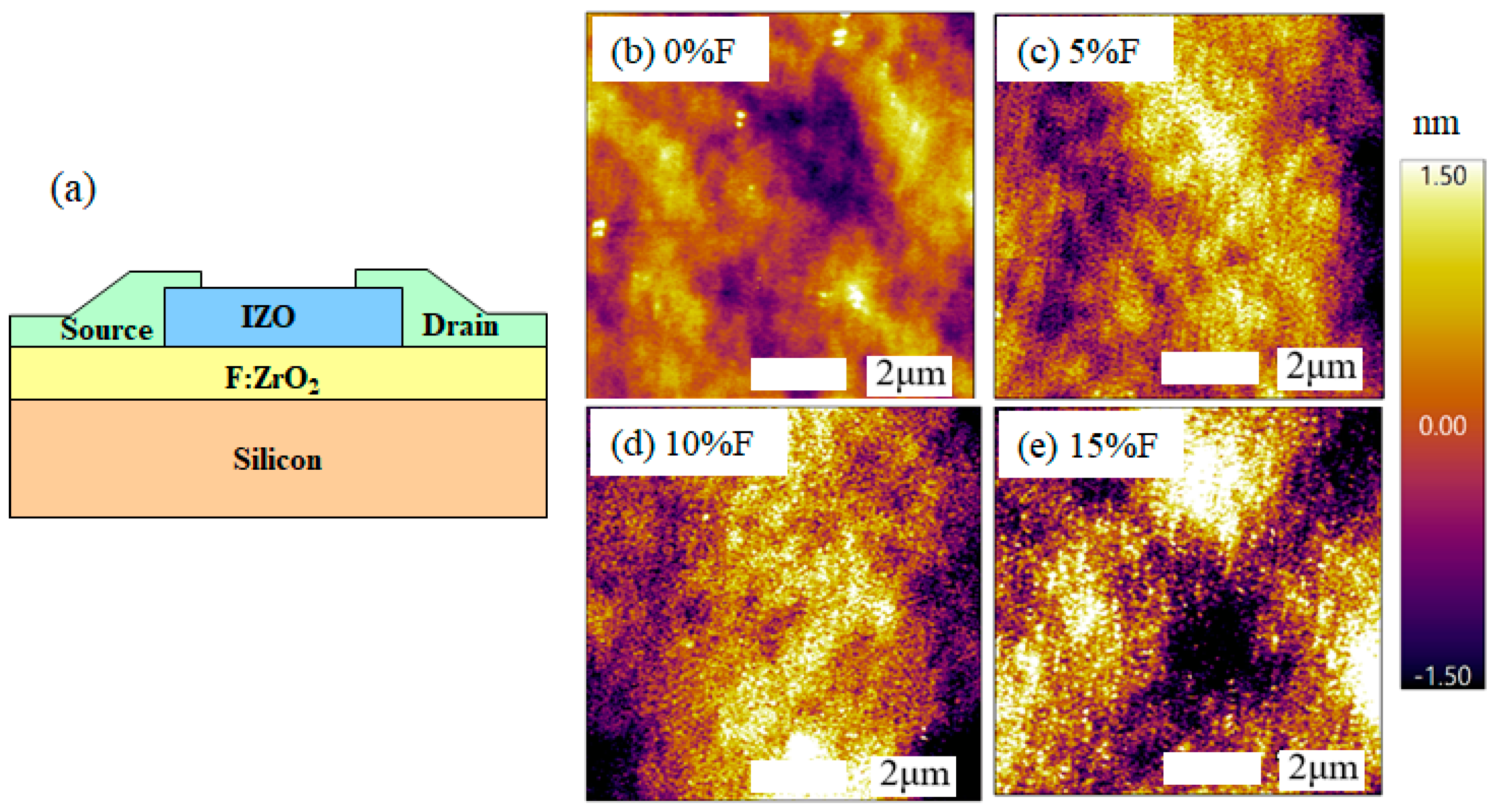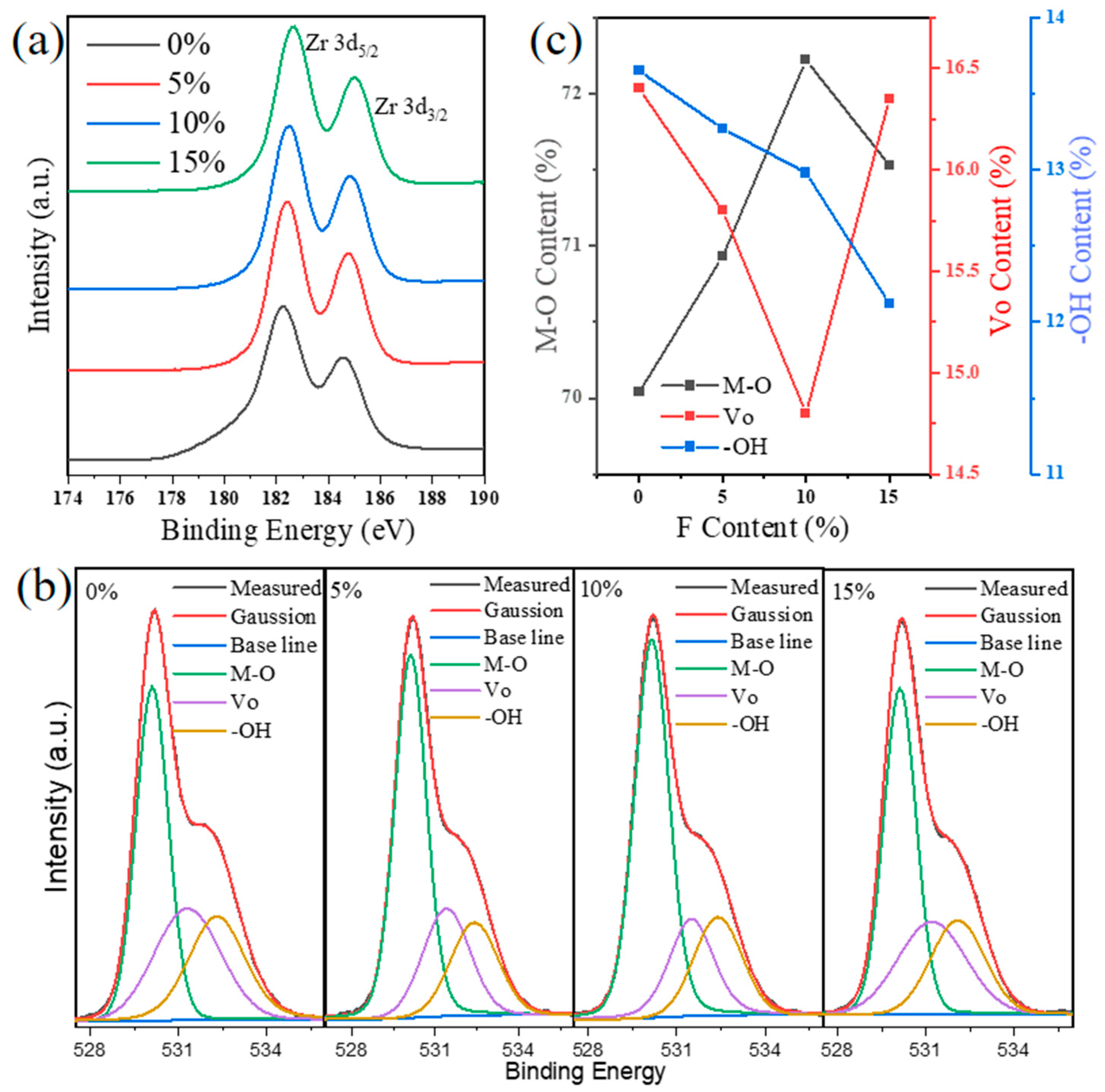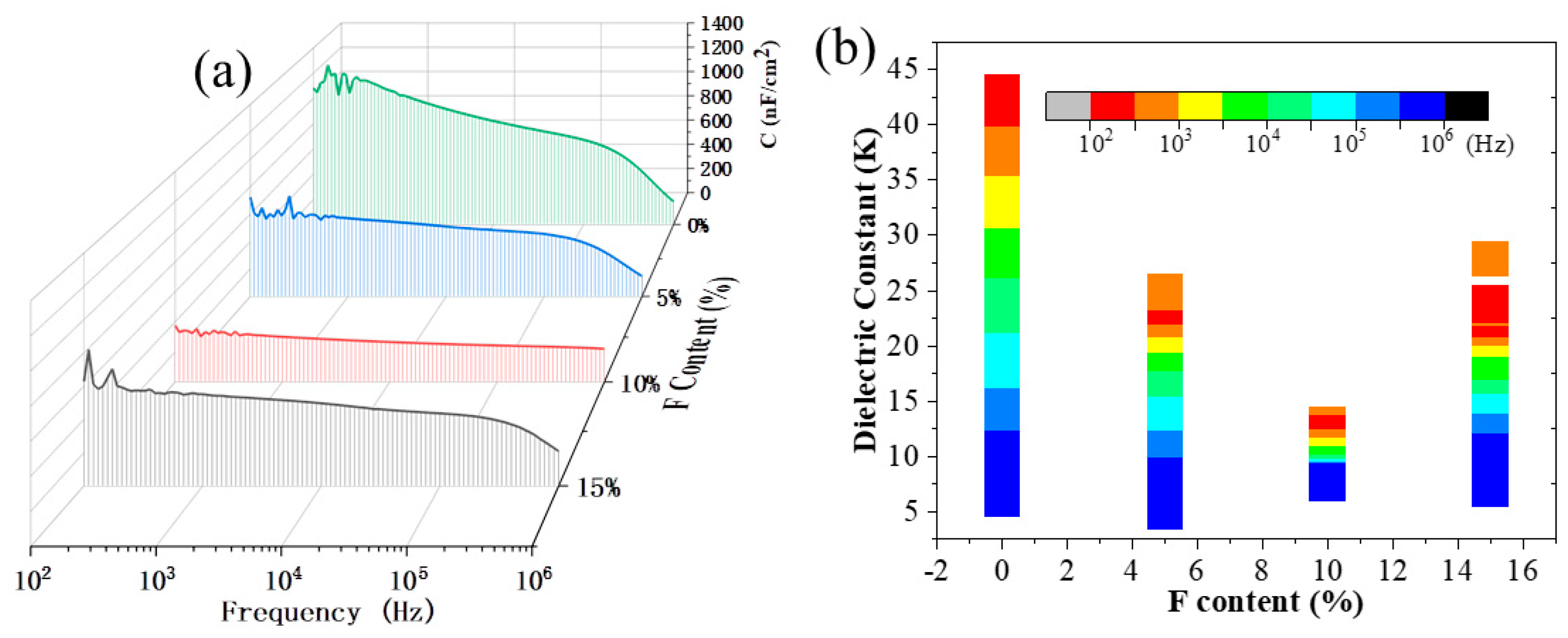Stability Improvement of Solution-Processed Metal Oxide Thin-Film Transistors Using Fluorine-Doped Zirconium Oxide Dielectric
Abstract
1. Introduction
2. Materials and Methods
2.1. Preparation of the Precursor
2.2. Device Fabrication
2.3. Characterization
3. Results
4. Conclusions
Author Contributions
Funding
Institutional Review Board Statement
Informed Consent Statement
Data Availability Statement
Conflicts of Interest
References
- Liang, Z.H.; Wu, W.J.; Fang, Z.Q.; Deng, Z.E.; Fu, X.; Ning, H.L.; Luo, D.X.; Zhu, Z.N.; Yao, R.H.; Peng, J.B. A review of doped metal oxide semiconductors in the stability of thin film transistors. J. Alloys Compd. 2025, 1010, 177434. [Google Scholar] [CrossRef]
- Kim, T.; Choi, C.H.; Hur, J.S.; Ha, D.; Kuh, B.J.; Kim, Y.; Cho, M.H.; Kim, S.; Jeong, J.K. Progress, Challenges, and Opportunities in Oxide Semiconductor Devices: A Key Building Block for Applications Ranging from Display Backplanes to 3D Integrated Semiconductor Chips. Adv. Mater. 2023, 35, 2204663. [Google Scholar] [CrossRef]
- Geng, D.; Wang, K.; Li, L.; Myny, K.; Nathan, A.; Jang, J.; Kuo, Y.; Liu, M. Thin-film transistors for large-area electronics. Nat. Electron. 2023, 6, 963–972. [Google Scholar] [CrossRef]
- Ma, L.Y.; Soin, N.; Aidit, S.N.; Rezali, F.A.M.; Hatta, S. Recent advances in flexible solution-processed thin-film transistors for wearable electronics. Mater. Sci. Semicond. Process. 2023, 165, 107658. [Google Scholar] [CrossRef]
- Troughton, J.; Atkinson, D. Amorphous InGaZnO and metal oxide semiconductor devices: An overview and current status. J. Mater. Chem. C 2019, 7, 12388–12414. [Google Scholar] [CrossRef]
- Wang, B.H.; Huang, W.; Chi, L.F.; Al-Hashimi, M.; Marks, T.J.; Facchetti, A. High-k Gate Dielectrics for Emerging Flexible and Stretchable Electronics. Chem. Rev. 2018, 118, 5690–5754. [Google Scholar] [CrossRef]
- Lee, H.; Islam, M.M.; Bae, J.; Jeong, M.; Roy, S.; Lim, T.; Rabbi, M.H.; Jang, J. A Coplanar Crystalline InGaO Thin Film Transistor with SiO2 Gate Insulator on ZrO2 Ferroelectric Layer: A New Ferroelectric TFT Structure. Adv. Mater. Technol. 2024, 10, 2401075. [Google Scholar] [CrossRef]
- Avis, C.; Jang, J. Influence of NF3 Plasma-Treated HfO2 Gate Insulator Surface on Tin Oxide Thin-Film Transistors. Materials 2023, 16, 7172. [Google Scholar] [CrossRef]
- Arulkumar, S.; Parthiban, S.; Eithiraj, R.D. In-Si-O thin-film transistors with atomic layer deposition-grown Al2O<sub>3</sub> gate insulator. J. Mater. Sci.-Mater. Electron. 2024, 35, 2063. [Google Scholar] [CrossRef]
- Cingolani, R.; Di Dio, M.; Lomascolo, M.; Rinaldi, R.; Prete, P.; Vasanelli, L.; Vanzetti, L.; Bassani, F.; Bonanni, A.; Sorba, L.; et al. Photocurrent spectroscopy of Zn1−xCdxSe/ZnSe quantum wells in p-i-n heterostructures. Phys. Rev. B 1994, 50, 12179–12182. [Google Scholar] [CrossRef]
- Kosacki, I.; Suzuki, T.; Petrovsky, V.; Anderson, H.U. Electrical conductivity of nanocrystalline ceria and zirconia thin films. Solid State Ion. 2000, 136, 1225–1233. [Google Scholar] [CrossRef]
- Lee, S.; Nam, J.; Choi, Y.; Jeong, J.; Nam, M.K.; Oh, H.; Kim, H.; Park, Y.; Kim, Y.; Jeon, W. Achieving Equivalent Oxide Thickness Scaling of a ZrO2 Dielectric Thin Film via Gd Doping without Sacrificing Tetragonal Crystallinity. Acs Appl. Electron. Mater. 2024, 6, 8979–8986. [Google Scholar] [CrossRef]
- Zhuang, X.M.; Patel, S.; Zhang, C.; Wang, B.H.; Chen, Y.; Liu, H.Y.; Dravid, V.P.; Yu, J.S.; Hu, Y.Y.; Huang, W.; et al. Frequency-Agile Low-Temperature Solution-Processed Alumina Dielectrics for Inorganic and Organic Electronics Enhanced by Fluoride Doping. J. Am. Chem. Soc. 2020, 142, 12440–12452. [Google Scholar] [CrossRef]
- Wolf, D.; Lubk, A.; Prete, P.; Lovergine, N.; Lichte, H. 3D mapping of nanoscale electric potentials in semiconductor structures using electron-holographic tomography. J. Phys. D Appl. Phys. 2016, 49, 364004. [Google Scholar] [CrossRef]
- Tsai, J.T.H.; Lee, B.H.B.; Yang, M.S. Fabrication of ZnO thin film transistors by atomic force microscopy nanolithogrophy through zinc thin films. Phys. Rev. B 2009, 80, 245215. [Google Scholar] [CrossRef]
- Chang, P.C.; Lee, J.; Huang, D.; Subramanian, V.; Murphy, A.R.; Frechet, J.M.J. Film morphology and thin film transistor performance of solution-processed oligothiophenes. Chem. Mater. 2004, 16, 4783–4789. [Google Scholar] [CrossRef]
- Kumar, A.; Mondal, S.; Rao, K. Low temperature solution processed high-κ ZrO2 gate dielectrics for nanoelectonics. Appl. Surf. Sci. 2016, 370, 373–379. [Google Scholar] [CrossRef]
- Panda, D.; Tseng, T.Y. Growth, dielectric properties, and memory device applications of ZrO2 thin films. THIN SOLID Film. 2013, 531, 1–20. [Google Scholar] [CrossRef]
- Mativenga, M.; Haque, F.; Billah, M.M.; Um, J.G. Origin of light instability in amorphous IGZO thin-film transistors and its suppression. Sci. Rep. 2021, 11, 14618. [Google Scholar] [CrossRef]
- Kim, H.; Maeng, S.; Lee, S.; Kim, J. Improved Performance and Operational Stability of Solution-Processed InGaSnO (IGTO) Thin Film Transistors by the Formation of Sn-O Complexes. Acs Appl. Electron. Mater. 2021, 3, 1199–1210. [Google Scholar] [CrossRef]
- Li, J.; Zhou, Y.-H.; Zhong, D.-Y.; Zhang, J.-H. Fluorine-controlled subgap states and negative bias illumination stability behavior in solution-processed InZnOF thin-film transistor. Appl. Phys. A 2019, 125, 527. [Google Scholar] [CrossRef]
- Lin, Z.Y.; Kang, L.; Zhao, J.X.; Yin, Y.; Wang, Z.H.; Yu, J.; Li, Y.; Yi, G.Z.; Nathan, A.; Li, X.Y.; et al. The Role of Oxygen Vacancy and Hydrogen on the PBTI Reliability of ALD IGZO Transistors and Process Optimization. IEEE Trans. Electron Devices 2024, 71, 3002–3008. [Google Scholar] [CrossRef]
- Kim, H.G.; Lee, H.J.; Lee, K.M.; Kim, T.G. Improved mobility and bias stability of Hf-doped IGZO/IZO/Hf-doped IGZO thin-film transistor. J. Alloys Compd. 2024, 981, 173587. [Google Scholar] [CrossRef]
- Xie, Z.J.; Li, X.H.; Liu, H.X.; Tang, J.; Wang, H. Improvement of Threshold Voltage With ZrO2/HfO2 Gate Dielectric and CF4 Plasma Treatment on AlGaN/GaN HEMT. IEEE Electron Device Lett. 2024, 45, 1125–1128. [Google Scholar] [CrossRef]
- Lee, J.S.; Chang, S.; Koo, S.M.; Lee, S.Y. High-Performance a-IGZO TFT With ZrO2 Gate Dielectric Fabricated at Room Temperature. IEEE Electron Device Lett. 2010, 31, 225–227. [Google Scholar] [CrossRef]
- Jiang, G.X.; Liu, A.; Liu, G.X.; Zhu, C.D.; Meng, Y.; Shin, B.; Fortunato, E.; Martins, R.; Shan, F.K. Solution-processed high-k magnesium oxide dielectrics for low-voltage oxide thin-film transistors. Appl. Phys. Lett. 2016, 109, 183508. [Google Scholar] [CrossRef]
- Seo, J.S.; Jeon, J.H.; Hwang, Y.H.; Park, H.; Ryu, M.; Park, S.H.K.; Bae, B.S. Solution-Processed Flexible Fluorine-doped Indium Zinc Oxide Thin-Film Transistors Fabricated on Plastic Film at Low Temperature. Sci. Rep. 2013, 3, srep02085. [Google Scholar] [CrossRef] [PubMed]
- Sil, A.; Goldfine, E.A.; Huang, W.; Bedzyk, M.J.; Medvedeva, J.E.; Facchetti, A.; Marks, T.J. Role of Fluoride Doping in Low-Temperature Combustion-Synthesized ZrOx Dielectric Films. ACS Appl. Mater. Interfaces 2022, 14, 12340–12349. [Google Scholar] [CrossRef]
- Liu, A.; Zhu, H.H.; Guo, Z.D.; Meng, Y.; Liu, G.X.; Fortunato, E.; Martins, R.; Shan, F.K. Solution Combustion Synthesis: Low-Temperature Processing for p-Type Cu:NiO Thin Films for Transparent Electronics. Adv. Mater. 2017, 29, 1701599. [Google Scholar] [CrossRef]
- Xu, W.Y.; Wang, H.; Ye, L.; Xu, J.B. The role of solution-processed high-κ gate dielectrics in electrical performance of oxide thin-film transistors. J. Mater. Chem. C 2014, 2, 5389–5396. [Google Scholar] [CrossRef]
- Li, Y.X.; Liang, R.R.; Wang, J.B.; Jiang, C.S.; Xiong, B.K.; Liu, H.F.; Wang, Z.B.; Wang, X.F.; Pang, Y.; Tian, H.; et al. Negative Capacitance Oxide Thin-Film Transistor With Sub-60 mV/Decade Subthreshold Swing. IEEE Electron Device Lett. 2019, 40, 826–829. [Google Scholar] [CrossRef]
- Dutta, G.; Hembrarn, K.; Rao, G.M.; Waghmare, U.V. Enhanced dielectric response of ZrO2 upon Ti doping and introduction of O vacancies. J. Appl. Phys. 2008, 103, 016102. [Google Scholar] [CrossRef]
- Lim, W.; Kim, S.H.; Wang, Y.L.; Lee, J.W.; Norton, D.P.; Pearton, S.J.; Ren, F.; Kravchenko, I.I. Stable room temperature deposited amorphous InGaZnO4 thin film transistors. J. Vac. Sci. Technol. B 2008, 26, 959–962. [Google Scholar] [CrossRef]
- Boratto, M.H.; Scalvi, L.V.A.; Goncharova, L.V.; Fanchini, G. Effects of Solution History on Sol-Gel Processed Tin-Oxide Thin-Film Transistors. J. Am. Ceram. Soc. 2016, 99, 4000–4006. [Google Scholar] [CrossRef]





Disclaimer/Publisher’s Note: The statements, opinions and data contained in all publications are solely those of the individual author(s) and contributor(s) and not of MDPI and/or the editor(s). MDPI and/or the editor(s) disclaim responsibility for any injury to people or property resulting from any ideas, methods, instructions or products referred to in the content. |
© 2025 by the authors. Licensee MDPI, Basel, Switzerland. This article is an open access article distributed under the terms and conditions of the Creative Commons Attribution (CC BY) license (https://creativecommons.org/licenses/by/4.0/).
Share and Cite
Xu, H.; Deng, B.; Zhang, X. Stability Improvement of Solution-Processed Metal Oxide Thin-Film Transistors Using Fluorine-Doped Zirconium Oxide Dielectric. Materials 2025, 18, 1980. https://doi.org/10.3390/ma18091980
Xu H, Deng B, Zhang X. Stability Improvement of Solution-Processed Metal Oxide Thin-Film Transistors Using Fluorine-Doped Zirconium Oxide Dielectric. Materials. 2025; 18(9):1980. https://doi.org/10.3390/ma18091980
Chicago/Turabian StyleXu, Haoxuan, Bo Deng, and Xinan Zhang. 2025. "Stability Improvement of Solution-Processed Metal Oxide Thin-Film Transistors Using Fluorine-Doped Zirconium Oxide Dielectric" Materials 18, no. 9: 1980. https://doi.org/10.3390/ma18091980
APA StyleXu, H., Deng, B., & Zhang, X. (2025). Stability Improvement of Solution-Processed Metal Oxide Thin-Film Transistors Using Fluorine-Doped Zirconium Oxide Dielectric. Materials, 18(9), 1980. https://doi.org/10.3390/ma18091980






